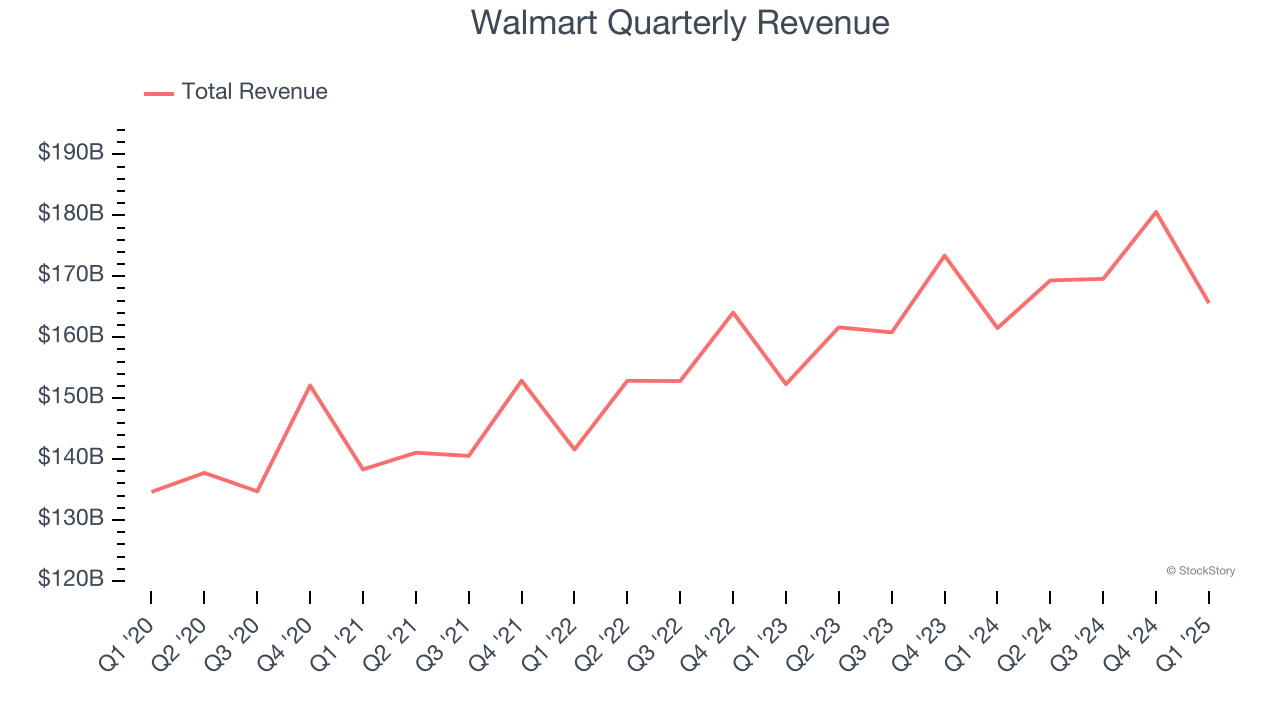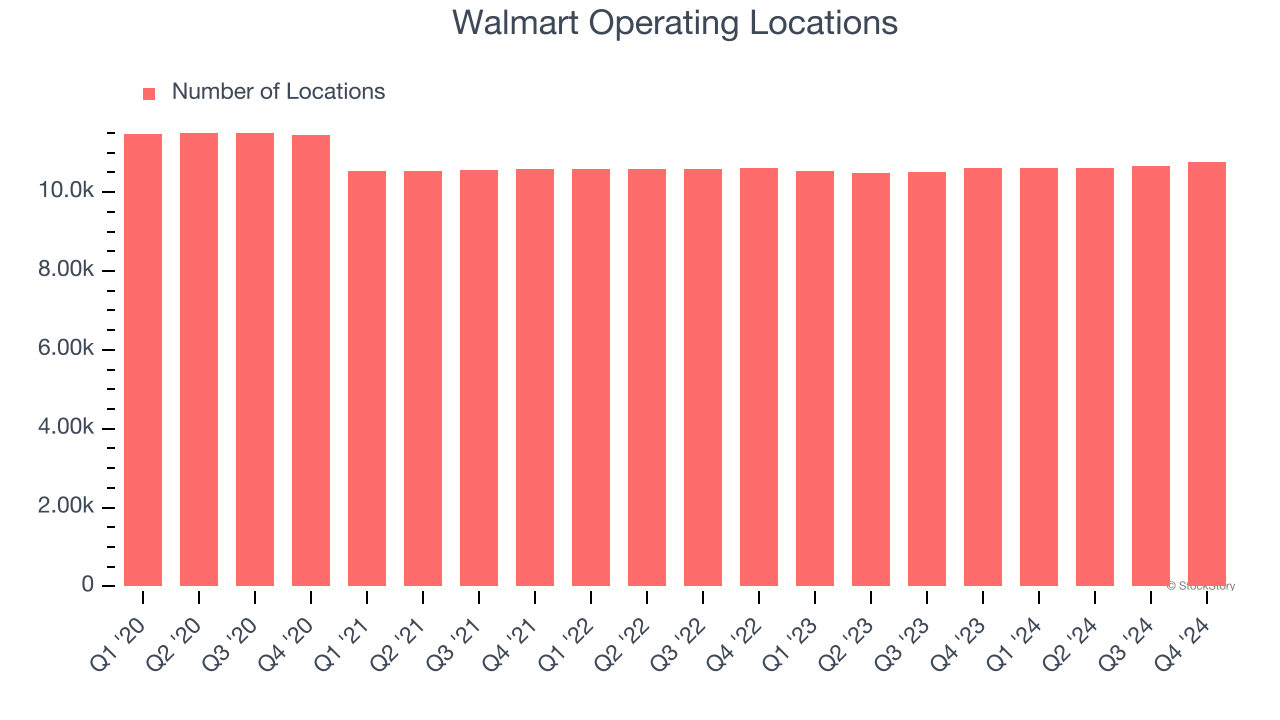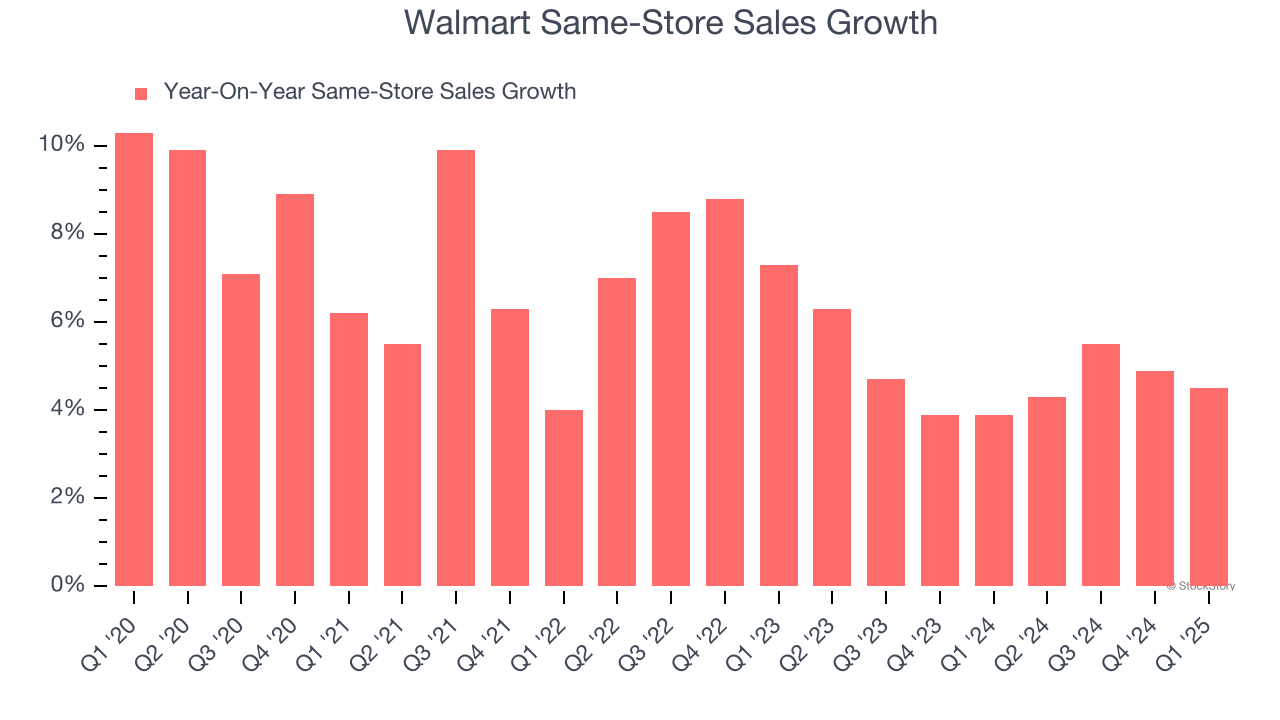
Retail behemoth Walmart (NYSE: WMT) met Wall Street’s revenue expectations in Q1 CY2025, with sales up 2.5% year on year to $165.6 billion. The company expects next quarter’s revenue to be around $176.1 billion, close to analysts’ estimates. Its non-GAAP profit of $0.61 per share was 5.7% above analysts’ consensus estimates.
Is now the time to buy Walmart? Find out by accessing our full research report, it’s free.
Walmart (WMT) Q1 CY2025 Highlights:
- Revenue: $165.6 billion vs analyst estimates of $166 billion (2.5% year-on-year growth, in line)
- Adjusted EPS: $0.61 vs analyst estimates of $0.58 (5.7% beat)
- Adjusted EBITDA: $10.5 billion vs analyst estimates of $10.35 billion (6.3% margin, 1.5% beat)
- Revenue Guidance for Q2 CY2025 is $176.1 billion at the midpoint, roughly in line with what analysts were expecting
- Management reiterated its full-year Adjusted EPS guidance of $2.55 at the midpoint
- CFO said higher prices could come as soon as later this month and June as a result of tariff uncertainty
- Company posted first profitable quarter for its e-commerce business
- Operating Margin: 4.3%, in line with the same quarter last year
- Free Cash Flow was $425 million, up from -$427 million in the same quarter last year
- Same-Store Sales rose 4.5% year on year, in line with the same quarter last year
- Market Capitalization: $774.7 billion
Company Overview
Known for its large-format Supercenters, Walmart (NYSE: WMT) is a retail pioneer that serves a budget-conscious consumer who is looking for a wide range of products under one roof.
Sales Growth
A company’s long-term sales performance is one signal of its overall quality. Any business can put up a good quarter or two, but many enduring ones grow for years.
With $685.1 billion in revenue over the past 12 months, Walmart is a behemoth in the consumer retail sector and benefits from economies of scale, giving it an edge in distribution. This also enables it to gain more leverage on its fixed costs than smaller competitors and the flexibility to offer lower prices. However, its scale is a double-edged sword because there is only so much real estate to build new stores, placing a ceiling on its growth. For Walmart to boost its sales, it likely needs to adjust its prices or lean into foreign markets.
As you can see below, Walmart grew its sales at a sluggish 4.8% compounded annual growth rate over the last six years (we compare to 2019 to normalize for COVID-19 impacts) as its store footprint remained unchanged.

This quarter, Walmart grew its revenue by 2.5% year on year, and its $165.6 billion of revenue was in line with Wall Street’s estimates. Company management is currently guiding for a 4% year-on-year increase in sales next quarter.
Looking further ahead, sell-side analysts expect revenue to grow 4.1% over the next 12 months, similar to its six-year rate. This projection is above average for the sector and suggests its newer products will help maintain its historical top-line performance.
Here at StockStory, we certainly understand the potential of thematic investing. Diverse winners from Microsoft (MSFT) to Alphabet (GOOG), Coca-Cola (KO) to Monster Beverage (MNST) could all have been identified as promising growth stories with a megatrend driving the growth. So, in that spirit, we’ve identified a relatively under-the-radar profitable growth stock benefiting from the rise of AI, available to you FREE via this link.
Store Performance
Number of Stores
A retailer’s store count influences how much it can sell and how quickly revenue can grow.
Walmart has kept its store count flat over the last two years while other consumer retail businesses have opted for growth.
When a retailer keeps its store footprint steady, it usually means demand is stable and it’s focusing on operational efficiency to increase profitability.
Note that Walmart reports its store count intermittently, so some data points are missing in the chart below.

Same-Store Sales
A company's store base only paints one part of the picture. When demand is high, it makes sense to open more. But when demand is low, it’s prudent to close some locations and use the money in other ways. Same-store sales provides a deeper understanding of this issue because it measures organic growth at brick-and-mortar shops for at least a year.
Walmart has been one of the most successful retailers over the last two years thanks to skyrocketing demand within its existing locations. On average, the company has posted exceptional year-on-year same-store sales growth of 4.8%. Given its flat store base over the same period, this performance stems from not only increased foot traffic at existing locations but also higher e-commerce sales as demand shifts from in-store to online.

In the latest quarter, Walmart’s same-store sales rose 4.5% year on year. This performance was more or less in line with its historical levels.
Key Takeaways from Walmart’s Q1 Results
It was encouraging to see Walmart beat analysts’ gross margin and EPS expectations this quarter despite in-line revenue. Revenue guidance for next quarter was roughly in line with expectations, and full-year EPS guidance was maintained. The company said it posted the first ever profitable quarter for its e-commerce business. Zooming out, it wasn't a perfect quarter, but we think this quarter had some key positives. The stock traded up 2.9% to $99.61 immediately after reporting.
Is Walmart an attractive investment opportunity right now? When making that decision, it’s important to consider its valuation, business qualities, as well as what has happened in the latest quarter. We cover that in our actionable full research report which you can read here, it’s free.







